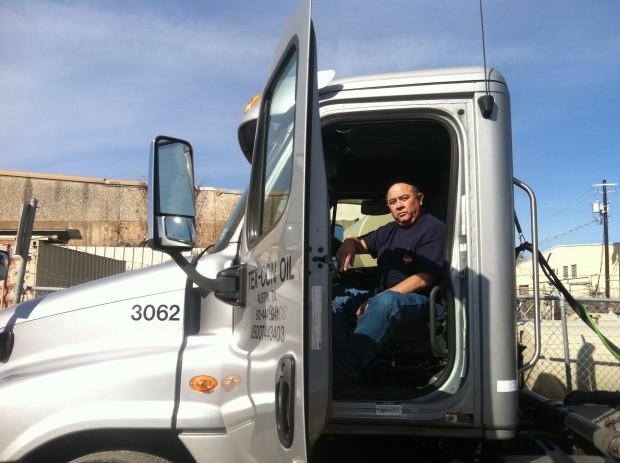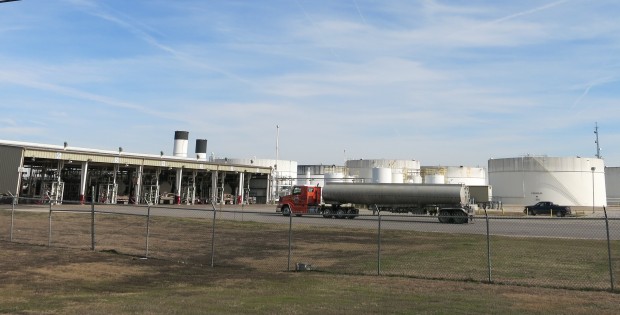From Pipeline to Pump, How Gasoline Gets to Your Car

Photo by Mose Buchele
Johnny Herrera is a dispatcher for Tex Con Oil. A company that distributes fuel around the Austin area.
By now, the initial surprise over low gas prices has worn off. But people looking for the very best deals might have noticed a trend: small, unbranded gas stations are often the first to cut prices. Many of them continue to stay competitive even when larger brand-name stations cut their prices as well.
To understand why stations offer different prices for essentially the same product, it helps to take a trip from the pump back to the pipeline, to see exactly how gas is bought, sold and transported.
The Pump
“It’s definitely savings,” said Doug Warden as he filled up his car at Pronto Food Mart recently, “like I just got a bonus!”
Pronto is a tiny neighborhood gas station that was one of the first places in Austin to slash prices. It still offers the cheapest gas in Central Austin according to websites that track prices. That’s no surprise. The shopkeepers there pride themselves on being on the front lines of the war against high gas prices.
“We initiated the low prices in Austin,” says Al Mak, one of the store’s managers. “Because no one was going down. The gas was coming in at a lower cost, but people sustained the higher prices!”
Pronto can afford to undercut the competition because it buys unbranded gasoline. There’s no big oil company sign at the store. When Mak sees a station with a Shell or Chevron sign, he’s thinking one thing.
“Under contract my friend! For 15, 20 years,” he says. “(They) can’t offer lowest prices like we do!”
Pronto gets its gas from a fuel distributor, known in the business as a “jobber.” The jobber has contracts with different oil companies and controls fleets of trucks that go buy fuel, branded and unbranded, at a central distribution hub called a “rack.”
“That’s where the large tanker trucks pick up the fuel and distribute to all the retail stations,” says Denton Cinquegrana, Chief Oil Analyst with Oil Price Information Service. “A lot of the racks will have maybe as many as ten different suppliers. And if you’re not tied to a contract, you could almost choose from any one of those particular suppliers on a given day.”
Cinquegrana says large chain stores also take advantage of unbranded gas.
“The Costcos, the Sam’s Clubs – they may be able to negotiate themselves better terms because they sell so much gasoline,” he said.
The Rack
A PR representative from Koch Enterprises, the parent company of the business that runs racks in the Austin area, denied our request to visit. But the operation is plainly visible from the road.
The rack sits in an industrial section of North East Austin. There are some offices, a fuel truck loading bay, and a collection of huge white tanks marked “premium,” “unleaded,” “fuel oil.” Tanker trucks idle as they wait their turn to load. This is Austin’s direct link up to Gulf Coast oil refineries. It looks like a gas station for gas stations.
“That’s pretty much where all the fuel trucks you see running around town eventually migrate back to the rack,” says Clay Johnson. Johnson is President of Tex Con Oil fuel distributors in Austin, a Jobber.
“The fuel gets to them via pipeline, and it gets piped up from Corpus Christi,” he says, “and then customers like us will go out and distribute it around town.”
The rack is also where ethanol is added, and where and big oil companies mix in their special additives to make the fuel their own.
“Basically if we’re delivering to a Shell store, well go pick up shell gasoline. If it’s not a branded convenience store typically they don’t care what brand it comes from,” says Johnson. “And you do get different pricing from each major oil company every day.”
Johnson says gas stations that sign a contract with an oil company get some perks. For one, there’s brand recognition. Big oil companies put secret additives into their fuel at the rack that they say help your engine (though studies indicate that unbranded gas is just fine for your car).
Most importantly: Contracts provide a stable supply if gas gets scarce.
“That supply agreement comes in handy when product gets tight,” said Johnson, “this last fall through November the whole chain from San Antonio to Austin, diesel supply was very tight. It was hard to get, so it was nice to have some relationships and some contracted supply at that time.”
But for smaller stations, the freedom to buy in at the lowest price is worth the risk. That’s because gas is not where they’re making most of their money.
“They’re willing to take less money on their gasoline sales,” said Denton Cinquegrana. “Lets say if the average margin in the area is ten cents a gallon, they’re willing to take maybe seven or eight cents to get you in a store to maybe buy a coffee or a sandwich. That’s where they’re real margins are.”
Back at Pronto Food Mart, Al Mak says the low prices have brought in more customers. He’s not too concerned about the will happen when the price of gas inevitably begins to rise again.
“If the prices go up we charge accordingly,” he says, “there’s not really a big challenge because everybody else will go up as well.”


